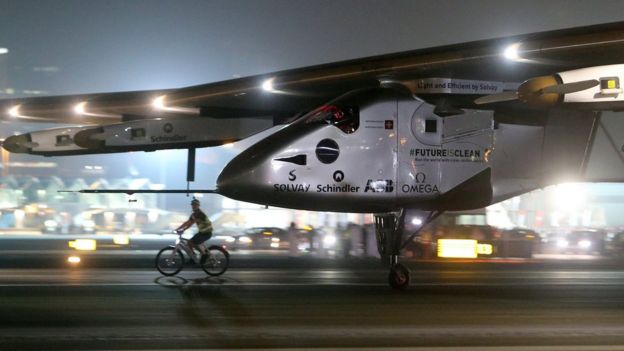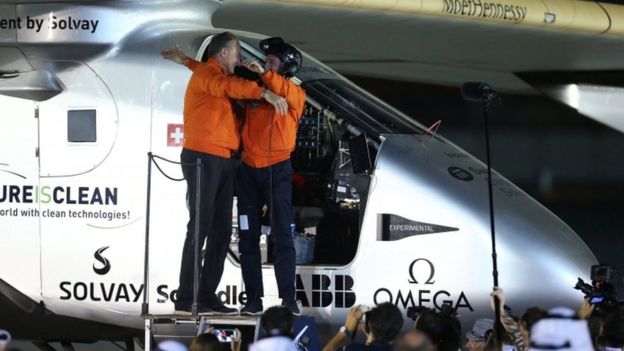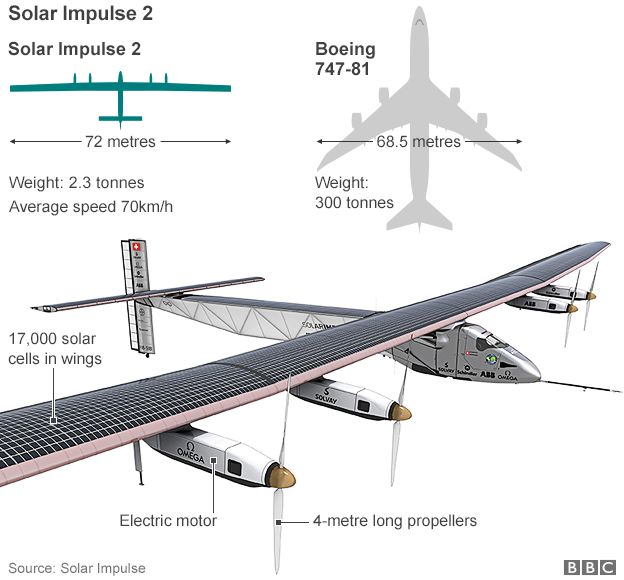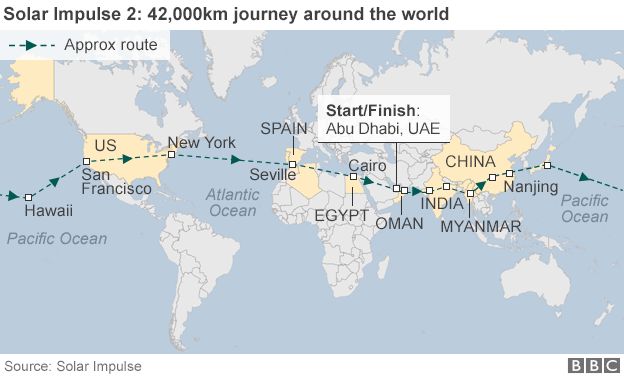Accessibility links Skip to contentAccessibility Help Sign in BBC navigation News Sport Weather Shop Earth Travel More Search the BBC Search Search the BBC News navigation Home Video World US & Canada UK Business Tech Science selected Magazine Entertainment & Arts Health More sections ADVERTISEMENT Science & Environment Solar Impulse completes historic round-the-world trip 26 July 2016 From the section Science & Environment Share Coming into landImage copyrightSOLAR IMPULSE Image caption Solar Impulse coming in to land in Abu Dhabi just before dawn The first round-the-world solar powered flight has been completed, after the Solar Impulse aircraft touched down in Abu Dhabi. Bertrand Piccard piloted the plane for a final time, steering it safely from the Egyptian capital Cairo to the UAE. He has been taking turns at the controls with Swiss compatriot Andre Borschberg, with the mission aiming to promote renewable energy. It brings to an end a voyage that began in Abu Dhabi on 9 March last year. "The future is clean. The future is you. The future is now. Let's take it further,'' Mr Piccard said, arriving into Abu Dhabi to cheers and applause. ADVERTISEMENT The 17-stage journey covered some 42,000km, taking in four continents, three seas and two oceans. Solar Impulse touches down at Al Bateen Executive AirportImage copyrightEPA Image caption Solar Impulse touched down at Al Bateen Executive Airport early on Tuesday Pilots Andre Borschberg (L) and Bertrand Piccard hug at the end of the Solar Impulse's round-the-world journeyImage copyrightREUTERS Image caption The two pilots embraced on landing The longest leg, an 8,924km (5,545-mile) flight from Nagoya in Japan to Hawaii, US, lasted nearly 118 hours and saw Mr Borschberg break the absolute world record for longest (time duration) uninterrupted solo flight. It was just one of 19 official aviation records set during the global adventure. Mr Piccard and Mr Borschberg have been working on the Solar Impulse project for more than a decade. The pair had hoped to complete the challenge last year but progress was not quite swift enough to get the best of the weather in the Northern Hemisphere's summer. And when battery damage was sustained on that epic five-day, five-night passage over the western Pacific in June/July 2015, the decision was taken to ground the effort for 10 months. Plane graphic Solar Impulse is no heavier than a car, but has the wingspan of a Boeing 747. It is powered by 17,000 solar cells. Its experimental design presents a number of technical difficulties, with the airplane being very sensitive to weather conditions. Indeed, the passage from Cairo was very bumpy for Mr Piccard as he battled severe turbulence above the hot Saudi desert. The cockpit is about the size of a public telephone box, with the pilots having to wear oxygen tanks to breathe at high altitude and permitted to only sleep for 20 minutes at a time. Map showing journey of Solar Impulse LEG 1: 9 March. Abu Dhabi (UAE) to Muscat (Oman) - 772km; 13 Hours 1 Minute LEG 2: 10 March. Muscat (Oman) to Ahmedabad (India) - 1,593km; 15 Hours 20 Minutes LEG 3: 18 March. Ahmedabad (India) to Varanasi (India) - 1,170km; 13 Hours 15 Minutes LEG 4: 18 March. Varanasi (India) to Mandalay (Myanmar) - 1,536km; 13 Hours 29 Minutes LEG 5: 29 March. Mandalay (Myanmar) to Chongqing (China) - 1,636km; 20 Hours 29 Minutes LEG 6: 21 April. Chongqing (China) to Nanjing (China) - 1,384km; 17 Hours 22 Minutes LEG 7: 30 May. Nanjing (China) to Nagoya (Japan) - 2,942km; 1 Day 20 Hours 9 Minutes LEG 8: 28 June. Nagoya (Japan) to Kalaeloa, Hawaii (US) - 8,924km; 4 Days 21 Hours 52 Minutes LEG 9: 21 April. Kalaeloa, Hawaii (US) to Mountain View, California (US) - 4,523km; 2 Days 17 Hours 29 Minutes LEG 10: 2 May. Mountain View, California (US) to Phoenix, Arizona (US) - 1,199km; 15 Hours 52 Minutes LEG 11: 12 May. Phoenix, Arizona (US) to Tulsa, Oklahoma (US) - 1,570 km; 18 Hours 10 Minutes LEG 12: 21 May. Tulsa, Oklahoma (US) to Dayton, Ohio (US) - 1,113 km; 16 Hours 34 Minutes LEG 13: 25 May. Dayton, Ohio (US) to Lehigh Valley, Pennsylvania (US) - 1,044 km; 16 Hours 47 Minutes LEG 14: 11 June. Lehigh Valley, Pennsylvania (US) to New York (US) - 230km; 4 Hours 41 Minutes LEG 15: 20 June. New York (US) to Seville (Spain) - 6,765km; 2 Days 23 Hours 8 minutes LEG 16: 11 July. Seville (Spain) to Egypt (Cairo) - 3,745km; 2 Days 50 Minutes LEG 17: 23 July. Egypt (Cairo) to Abu Dhabi (UAE) - 2,694 km; 2 Days 47 Minutes
Solar Impulse completes historic round-the-world trip
- 26 July 2016
- Science & Environment
 SOLAR IMPULSE
SOLAR IMPULSE
The first round-the-world solar powered flight has been completed, after the Solar Impulse aircraft touched down in Abu Dhabi.
Bertrand Piccard piloted the plane for a final time, steering it safely from the Egyptian capital Cairo to the UAE.
He has been taking turns at the controls with Swiss compatriot Andre Borschberg, with the mission aiming to promote renewable energy.
It brings to an end a voyage that began in Abu Dhabi on 9 March last year.
"The future is clean. The future is you. The future is now. Let's take it further,'' Mr Piccard said, arriving into Abu Dhabi to cheers and applause.
The 17-stage journey covered some 42,000km, taking in four continents, three seas and two oceans.
 EPA
EPA REUTERS
REUTERS
The longest leg, an 8,924km (5,545-mile) flight from Nagoya in Japan to Hawaii, US, lasted nearly 118 hours and saw Mr Borschberg break the absolute world record for longest (time duration) uninterrupted solo flight.
It was just one of 19 official aviation records set during the global adventure.
Mr Piccard and Mr Borschberg have been working on the Solar Impulse project for more than a decade.
The pair had hoped to complete the challenge last year but progress was not quite swift enough to get the best of the weather in the Northern Hemisphere's summer.
And when battery damage was sustained on that epic five-day, five-night passage over the western Pacific in June/July 2015, the decision was taken to ground the effort for 10 months.

Solar Impulse is no heavier than a car, but has the wingspan of a Boeing 747. It is powered by 17,000 solar cells.
Its experimental design presents a number of technical difficulties, with the airplane being very sensitive to weather conditions.
Indeed, the passage from Cairo was very bumpy for Mr Piccard as he battled severe turbulence above the hot Saudi desert.
The cockpit is about the size of a public telephone box, with the pilots having to wear oxygen tanks to breathe at high altitude and permitted to only sleep for 20 minutes at a time.

LEG 1: 9 March. Abu Dhabi (UAE) to Muscat (Oman) - 772km; 13 Hours 1 Minute
LEG 2: 10 March. Muscat (Oman) to Ahmedabad (India) - 1,593km; 15 Hours 20 Minutes
LEG 3: 18 March. Ahmedabad (India) to Varanasi (India) - 1,170km; 13 Hours 15 Minutes
LEG 4: 18 March. Varanasi (India) to Mandalay (Myanmar) - 1,536km; 13 Hours 29 Minutes
LEG 5: 29 March. Mandalay (Myanmar) to Chongqing (China) - 1,636km; 20 Hours 29 Minutes
LEG 6: 21 April. Chongqing (China) to Nanjing (China) - 1,384km; 17 Hours 22 Minutes
LEG 7: 30 May. Nanjing (China) to Nagoya (Japan) - 2,942km; 1 Day 20 Hours 9 Minutes
LEG 8: 28 June. Nagoya (Japan) to Kalaeloa, Hawaii (US) - 8,924km; 4 Days 21 Hours 52 Minutes
LEG 9: 21 April. Kalaeloa, Hawaii (US) to Mountain View, California (US) - 4,523km; 2 Days 17 Hours 29 Minutes
LEG 10: 2 May. Mountain View, California (US) to Phoenix, Arizona (US) - 1,199km; 15 Hours 52 Minutes
LEG 11: 12 May. Phoenix, Arizona (US) to Tulsa, Oklahoma (US) - 1,570 km; 18 Hours 10 Minutes
LEG 12: 21 May. Tulsa, Oklahoma (US) to Dayton, Ohio (US) - 1,113 km; 16 Hours 34 Minutes
LEG 13: 25 May. Dayton, Ohio (US) to Lehigh Valley, Pennsylvania (US) - 1,044 km; 16 Hours 47 Minutes
LEG 14: 11 June. Lehigh Valley, Pennsylvania (US) to New York (US) - 230km; 4 Hours 41 Minutes
LEG 15: 20 June. New York (US) to Seville (Spain) - 6,765km; 2 Days 23 Hours 8 minutes
LEG 16: 11 July. Seville (Spain) to Egypt (Cairo) - 3,745km; 2 Days 50 Minutes
LEG 17: 23 July. Egypt (Cairo) to Abu Dhabi (UAE) - 2,694 km; 2 Days 47 Minutes
Comments